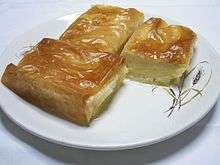Galaktoboureko
Galaktoboureko (Greek: γαλακτομπούρεκο) is an Ottoman dessert of semolina custard baked in filo.[2] The name means "milk börek". It may be made in a pan, with filo layered on top and underneath and cut into square portions, or rolled into individual servings (often approximately 10 cm (4 in) long). It is served or coated with a clear, sweet syrup. The custard may be flavored with lemon, orange, or rose.
 Three pieces of galaktoboureko | |
| Type | Pastry |
|---|---|
| Place of origin | Ottoman Empire |
| Main ingredients | Phyllo, semolina custard[1] |
Unlike mille-feuille, which it otherwise resembles, the custard is baked with the pastry,[3] not added afterwards.
.jpg)
The Turkish laz böreği is similar, but is made with a type of pudding called muhallebi instead of semolina custard. It is popular in Rize and Artvin provinces in the Black Sea Region, home of many Laz people.[4][5] Laz böreği is now available across Turkey.[6]
The Turkish şöbiyet is made with semolina custard but is folded in small triangle shapes instead of squares.[7]
References
- "Galaktoboureko". Allrecipes.com. Retrieved 22 June 2017.
- "Semolina custard pastry with syrup (galaktoboureko)". SBS Food. Special Broadcasting Service. May 2014. Retrieved 20 June 2019.
- "Galaktoboureko". Food.com. Retrieved 22 June 2017.
- Timothy G. Roufs; Kathleen Smyth Roufs (29 July 2014). Sweet Treats around the World: An Encyclopedia of Food and Culture: An Encyclopedia of Food and Culture. ABC-CLIO. p. 341. ISBN 978-1-61069-221-2.
- Özhan Öztürk (2005). Karadeniz: ansiklopedik sözlük. Heyamola Yayınları. ISBN 978-975-6121-00-9.
- http://culinarybackstreets.com/cities-category/istanbul/2012/klemuri/
- A King's Confectioner in the Orient: Friedrich Unger, Court Confectioner to King Otto I, 1837